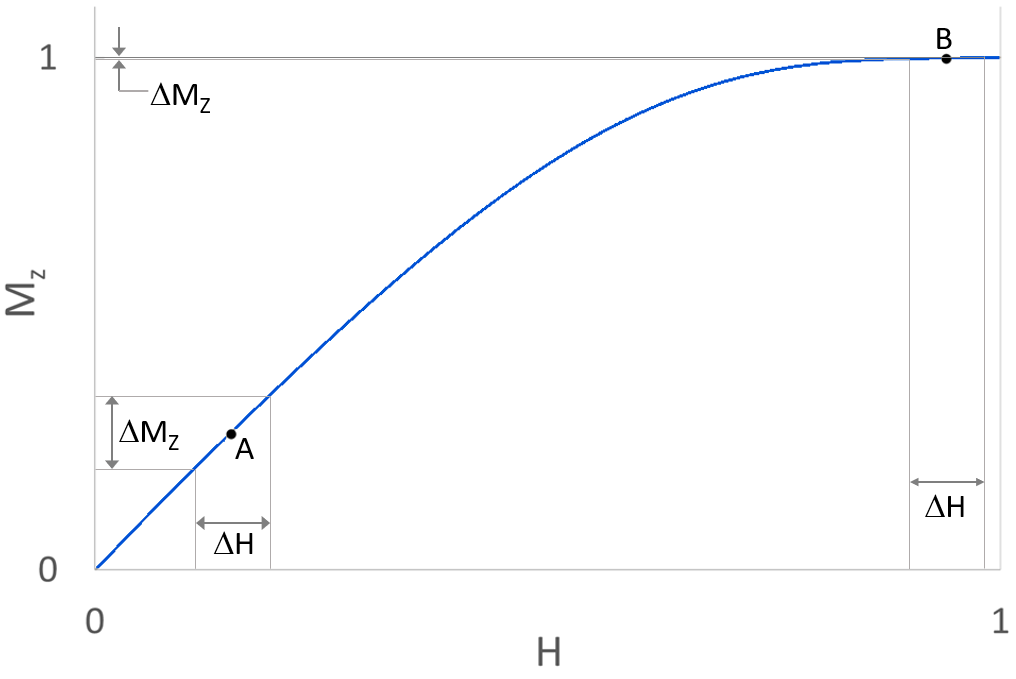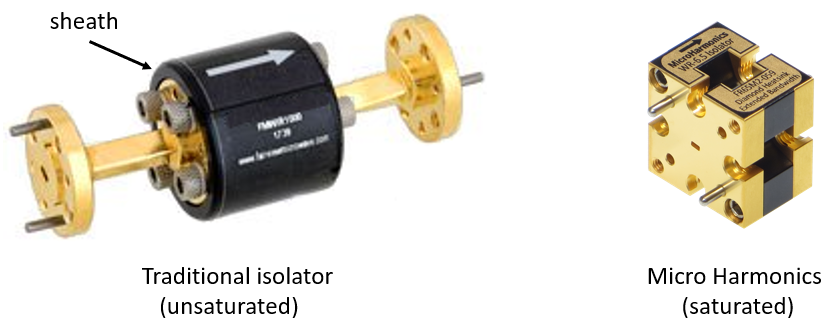Are Faraday Rotation Isolators Sensitive to Magnetic Fields?
Some Faraday rotation isolators are very sensitive to magnetic fields while others show almost no sensitivity at all. It depends on the magnetic bias point. Faraday rotation isolators employ a magnetically biased ferrite rod. An internal magnet or an array of magnets is used to bias the ferrite. The applied magnetic field aligns magnetic dipoles in the ferrite rod which in turn gives rise to the Faraday rotation effect. We define the magnetic fields produced by the internal bias magnets as the magnetic bias field. Magnetic fields from other sources outside the isolator we define as stray magnetic fields. So, when we refer to sensitivity to magnetic fields, we are referring to sensitivity to stray magnetic fields.
The sensitivity arises because stray magnetic fields either add to or subtract from the magnetic bias field which can increase or decrease the RF signal rotation. This requires a bit of explanation. The rotation angle, θ, of the signal as it passes through the ferrite rod is directly proportional to the ferrite magnetization, 4πMz, and the length of the ferrite rod, l, as shown in equation 1.

Application of an applied magnetic field (H) gives rise to a ferrite magnetization (4πMz) or simply (Mz). As the magnetic bias field (H) increases, the magnetization (Mz) increases. Magnetization reaches a saturation point beyond which additional increases in magnetic field (H) have almost no impact on magnetization (Mz). Figure 1 shows ferrite magnetization (Mz) versus magnetic bias field (H). The magnetization and magnetic field are normalized. For the Faraday rotation isolator to work properly, the signal polarity must rotate by 45° in a single pass through the ferrite rod. So, (Mz) and (l) must be properly adjusted to achieve the needed 45° rotation.
The Limitations of Magnetic Shields in Traditional Isolators
The problem is that stray magnetic fields either add to or subtract from the magnetic bias field resulting in a new magnetic operating point. Point “A” on the graph in Figure 1 shows a typical unsaturated magnetic bias point. This is the operating point used in most traditional Faraday rotation isolators. If the isolator is biased at point “A”, the lower magnetization must be offset by the use of a longer ferrite rod. For an isolator operating at point “A”, a change in the net magnetic bias field, ∆H, caused by a stray magnetic field can cause a large change in the ferrite magnetization, ∆Mz, and thus a significant change in the signal rotation. The RF signal is either under- or over-rotated as it passes through the ferrite rod. The degradation in isolation and insertion loss can be severe. In fact, even a moderate stray magnetic field can essentially turn the isolator into an attenuator. Increasing the stray field intensity further can even cause the isolator to reverse direction.
Figure 1 – Normalized axial magnetization (Mz) versus normalized magnetic bias field (H).
Point “B” on the graph shows the operating point where the minimum ferrite length and a saturating magnetic field are used to achieve the desired 45° signal rotation. In this case a similar change in the net magnetic bias field, ∆H, caused by a stray magnetic field does not appreciably change the ferrite magnetization and there is no impact on the signal rotation.
Traditional isolators, those operating at point “A”, employ a magnetic sheath or “magnetic shield”. Of course there is no such thing as a true magnetic shield. Magnetic flux passes through metals and dielectric materials just as easily as it passes through air. But there are magnetic materials that can be used to provide an improved or preferred path for magnetic flux. The strategy is to shunt the stray magnetic fields around the ferrite rod. But do the magnetic “shields” used in traditional Faraday rotation isolators achieve this aim? The answer is no, they don’t. They are largely window dressing, providing no appreciable shielding. This can easily be proven by placing the isolator on a vector network analyzer and watching what happens as a permanent magnet is brought into near proximity. The thing goes absolutely haywire. We made a video which shows this. Click here to learn more about, “Micro Harmonics Isolator Stray Magnet Comparison”.
Why Micro Harmonics Isolators Are Superior in High Magnetic Environments
Micro Harmonics isolators are biased into magnetic saturation. We use a very strong magnetic bias field that puts our ferrite rod at an operating point that is well to the right of point “B” on the graph in Figure 1. Even very strong stray magnetic fields have no impact on the performance of our isolators. We have proven this experimentally using very strong stray magnetic fields. The video referred to earlier also shows that our isolators are impervious to stray magnetic fields that absolutely wreck the traditional isolator.
So, which of the D-band isolators shown below in Figure 2 is resistant to stray magnetic fields? Many engineers might assume it is the one on the left since it has an outer mu metal sheath (black). Conversely, the isolator on the right, made by Micro Harmonics, doesn’t have a sheath. But in fact, it is the Micro Harmonics isolator that is highly resistant to stray magnetic fields while the sheathed isolator on the left is highly sensitive to stray fields. And now you know why.
Figure 2 – Traditional D-band isolator on left and Micro Harmonics D-band isolator on the right.
If you are interested in a more in depth analysis, please see our article titled, “The Impact of Stray Magnetic Fields on MMW Isolators,” which can provide you with better insight.
Why Choose Micro Harmonics Isolators for Magnetic Field Resistance?
To summarize, the choice of isolator and its operating point can significantly affect its sensitivity to stray magnetic fields. Unlike traditional Faraday rotation isolators that are vulnerable to even moderate stray fields, Micro Harmonics isolators use a strong magnetic bias field that places them in a state of magnetic saturation, making them impervious to such disturbances.
This robust design ensures consistent performance and reliability, even in high magnetic environments. If you have any questions or would like to learn more about our isolators, please don’t hesitate to reach out to Micro Harmonics. We’re here to help you make the best choice for your specific application.


